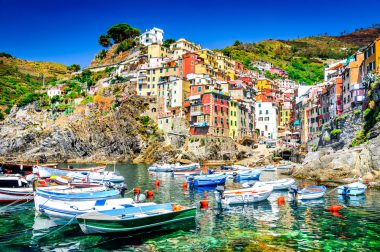Italy, the country at the boot of Europe, enjoys numerous beautiful stretches of coastline. This is one of the reasons why tourism experts argue about where a particularly romantic magic blows in “Bella Italia” and where the most colourful landscapes can be found. Some of them have no doubt that Cinque Terre deserves this title. The “five villages”, which line up like colourful pearls on a twelve-kilometre-long coastal strip, are ideal for a longer stay. Since 1997, the towns of Riomaggiore, Manarola, Corniglia, Vernazza and Monterosso al Mare have even been on the UNESCO list of World Natural and Cultural Heritage Sites. Eighty kilometres south of the metropolis of Genoa stretches a region that invites you to dream and linger.
Rugged cliffs and breathtaking views

Many paths lead to Cinque Terre and many paths on the Ligurian Riviera should be hiked if you want to get closer to the soul of Italy. “Macchia mediterranea” is what the inhabitants of this area call their largely untouched natural landscape with its rugged cliffs and countless breathtaking views that make the heart of every holidaymaker beat faster. Steep coasts stretch out in front of a rather lovely-looking green mountain range, and where they open up, pretty fishing villages have sprung up – the Cinque Terre. Four of these five towns have direct access to the Mediterranean Sea. Corniglia alone is located on a picturesque rocky outcrop at an altitude of one hundred meters.
Wine plantations on steep slopes
Until the early Middle Ages, this was the home of a Lombard noble family. Some historical documents indicate that wine was grown in the Cinque Terre area as early as 1050. The heritage of the winegrowers was maintained for centuries, although the steep terraces had to be repaired again and again because entire slopes slipped. Those who did not work in the wine plantations there hired themselves out as fishermen. In the 12th century, the rulers of the Republic of Genoa recognized the strategic importance of this wonderful landscape. And so an imposing fortress was built on Punta San Pietro near Porto Venere. For a long period of history, however, the pressing of grapes was the livelihood of the people who were lucky enough to live here, in this almost paradisiacal environment.
Villages, like swallows’ nests on the coast
The five villages of the Cinque Terre have for the most part retained their historic charm. There is a touch of history here, and tourists who don’t want to miss it marvel at the idyll of the five villages, which cling to the cliffs like the nests of swallows. For a long time, these places were almost cut off from the outside world and were not on the program of tourist flows. That has since changed, and today more and more holidaymakers are heading in their cars on the winding coastal roads that wind down to the five seaside idylls. In the months of the main tourist season, it is sometimes difficult to secure a parking space in the small towns by the sea. If you are good on foot, you can park your rolling vehicle at the train station in La Spezia.
A “path of love” under steep rocks

Vernazza claims to be the most photographed town in the Cinque Terre. This may be due in particular to the beautiful harbour. The typical Ligurian houses of the region are nestled against the hills, and the picturesque piazza is the traditional meeting place for visitors. The damage left behind by the flood disaster of 2011 has long since been repaired. The inhabitants of Manarola established themselves on two rocky cliffs. The small community is particularly proud of its famous Via dell’Amore. The so-called “Path of Love” is a footpath that connects the town to Riomaggiore and passes along the steep coast. Corniglia, the only village in the Cinque Terre that does not have direct access to the sea, is a little off the beaten track. From here there is a magnificent view of the Riviera. Riomaggiore has a special peculiarity, because the two parts of this town can only be reached through a tunnel. Those who are not bothered by the numerous pebbles in the bay will enjoy swimming in the “Spiaggia”.
A region protected by the National Park
The majority of holidaymakers reach the five romantic villages on the Ligurian Riviera by train. The ride alone is an attraction in itself, as the route repeatedly passes tunnels by the sea and alternates with impressive views. Tourism has long been the main source of income in the Cinque Terre and has outshone winegrowing and fishing there for many years. In addition to the Via Dell’Amore, hikers appreciate the numerous paths that lead through the vineyards and olive plantations. The entire region has barely more than 7,000 inhabitants and is protected by a national park in Italy . It is a primary goal of the landscape planners to change almost nothing here. The fascination of the Cinque Terre should be preserved for all time.
Können wir Ihnen helfen?
Benötigen Sie Unterstützung bei Ihrer Reiseplanung oder weitergehende Informationen zu einzelnen Reisezielen? Wir freuen uns über Ihre Kontaktaufnahme.


